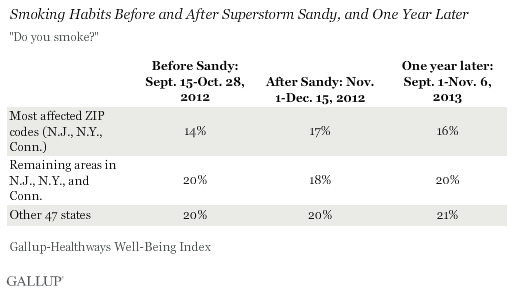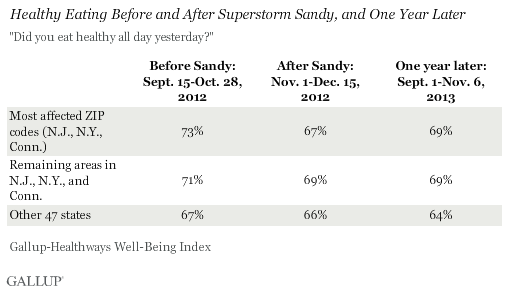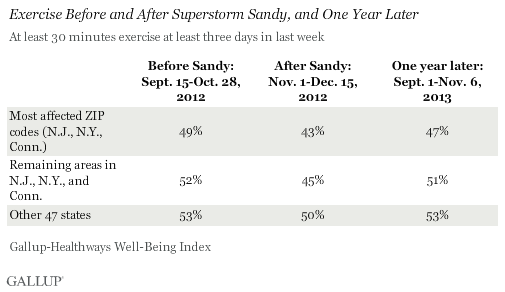WASHINGTON, D.C. -- One year after Superstorm Sandy, residents of the most affected ZIP codes in New Jersey, New York, and Connecticut are still more likely to smoke and less likely to eat healthy than they were before the disaster. However, they are as likely to report exercising frequently as they were before the storm.
The smoking rate remains elevated in the most affected areas, at 16%. This is similar to the 17% who reported smoking in the weeks immediately following Superstorm Sandy, but statistically greater than the 14% who smoked before the storm. Smoking rates in the rest of America are unchanged from what they were before the disaster.

The percentage of residents in the most affected areas who report eating healthy all day yesterday declined to 67% immediately following the storm from 73% before the storm, but has only inched up to 69% one year later. Thus, residents in the areas hardest hit remain less likely to eat healthy now than they were before the storm. Eating habits nationally, however, are similarly down by about the same amount one year later.

In contrast to smoking and healthy eating, exercise has improved from the immediate decline recorded after the storm and now nearly matches levels seen beforehand. One year after the storm, 47% of residents of the most affected ZIP codes report exercising for 30 minutes at least three days per week, improved from the 43% immediately following the storm. Residents of the remaining areas of New York, New Jersey, and Connecticut are now as likely to report exercising frequently as they were before the storm, offsetting significant declines that occurred in the storm's immediate aftermath.

These findings do not necessarily imply that the storm itself led to an increase in smoking, a decrease in healthy eating, or less exercising, or that recovery operations after the storm directly affected the behaviors that show improvement. Rather, they show that in the aggregate there has been measurable change in the time period before and after the storm in the areas most affected. In addition to actual changes due to the storm, the changes in healthy behaviors one year later could also be due to changes in the population or demographics of the affected areas over this time period. For example, those who reported that they smoked immediately following the storm may no longer reside in the area or nonsmokers may have moved into the affected areas.
These patterns in healthy behaviors from before, immediately following, and one year after the storm mirror the recovery in key emotional health metrics that Gallup previously reported.
Implications
Gallup-Healthways Well-Being Index data collected after Superstorm Sandy demonstrate how a major disaster can affect individual health choices, some of which can have lingering effects long after the original event. Fortunately for the health of the region most affected by Sandy, frequent exercise has bounced back within a year of the storm, but smoking and healthy eating have yet to return to levels seen before the storm.
However, it seems less likely that healthy eating will recover in the most affected areas, as it has significantly declined across the entire United States. In comparison, smoking and exercise levels did not change significantly on a national level during the same time period. While this national change may suggest that storm did not affect healthy eating trends within the region, there may be larger implications for poorer eating habits nationwide.
About the Gallup-Healthways Well-Being Index
The Gallup-Healthways Well-Being Index tracks U.S. well-being and provides best-in-class solutions for a healthier world. To learn more, please visit well-beingindex.com.
Survey Methods
The original 2012 results are based on 6,414 interviews conducted from Sept. 15-Dec. 15 with adult residents of New Jersey, New York, and Connecticut. Of these interviews, 1,713 occurred before the storm (Sept. 15-Oct. 28) and another 1,690 after the storm (Oct. 31-Dec. 15) in areas most impacted by Sandy, with another 1,433 before the storm and 1,578 after the storm among remaining residents of the three states. During the same period, 35,184 interviews were completed before the storm and 36,081 after it among residents of the remaining 47 states.
Results for one year later in 2013 are based on 2,995 interviews conducted from Sept. 1-Nov.6, with adult residents of New Jersey, New York, and Connecticut. Of these, 1,661 were conducted in the areas most impacted by Sandy, with another 1,334 with remaining residents of the three states. Another 30,701 interviews were completed adults in the 47 remaining states.
For results based on the three sample types for either before or after the storm, one can say with 95% confidence that the typical margin of sampling error is ±2.1, ±2.4, and ±0.5 percentage points, respectively, for each emotional health metric.
Interviews are conducted with respondents on landline telephones (for respondents with a landline telephone) and cellular phones (for respondents who are cellphone only).
In addition to sampling error, question wording and practical difficulties in conducting surveys can introduce error or bias into the findings of public opinion polls.
For more details on Gallup's polling methodology, visit www.gallup.com.
